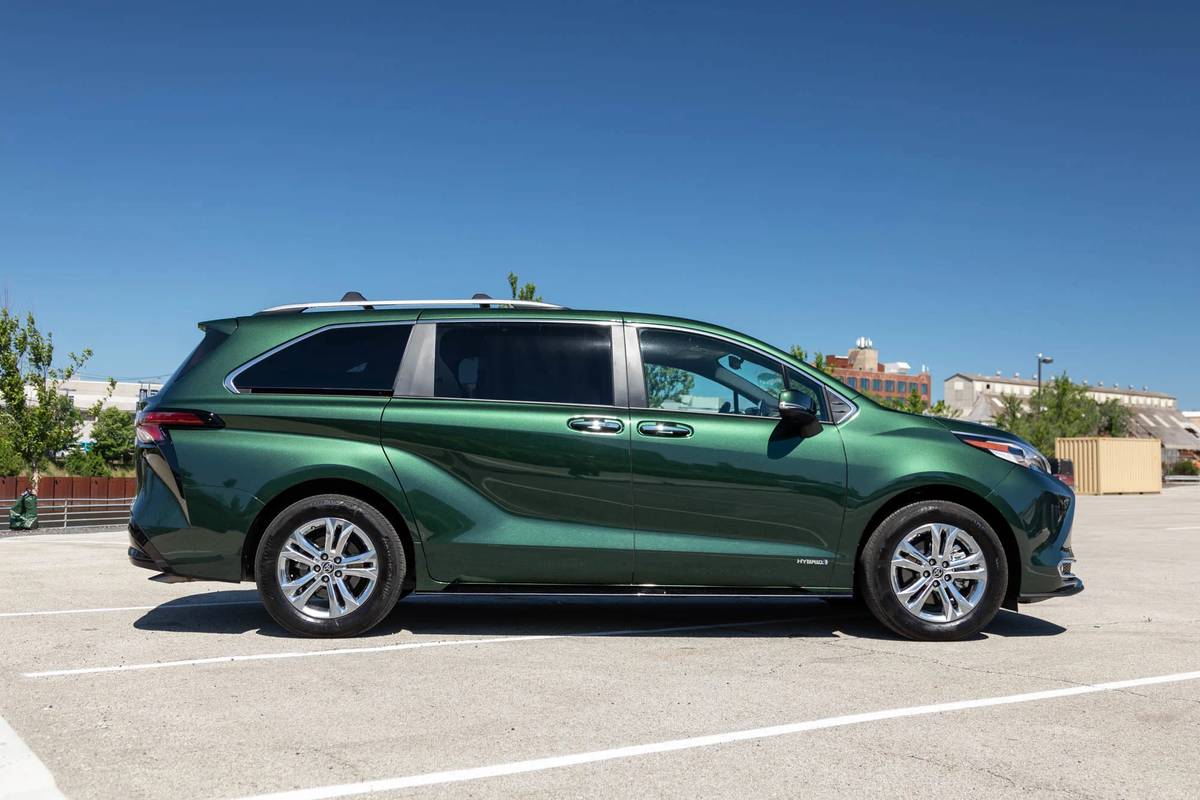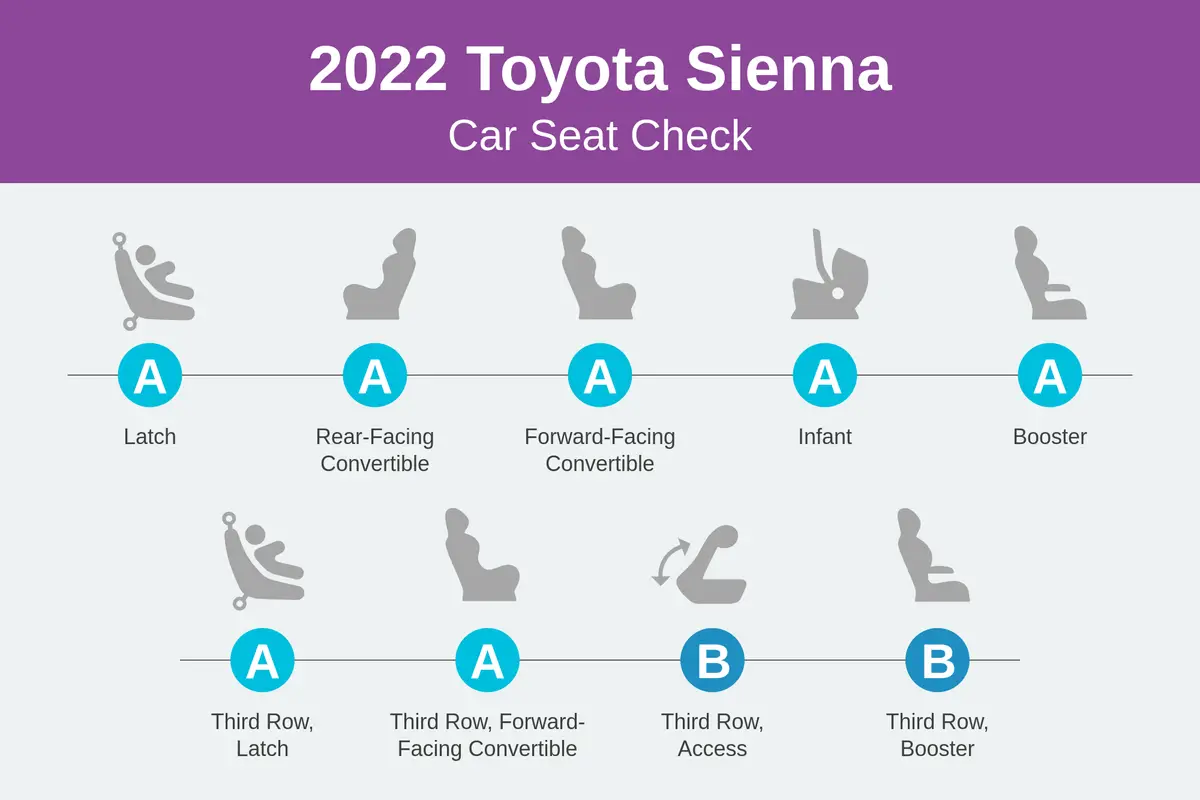How Do Car Seats Fit in a 2022 Toyota Sienna?


Editor’s note: This Car Seat Check was written in June 2021 about the 2021 Toyota Sienna. Little of substance has changed with this year’s model. See what’s new for 2022 or check out a side-by-side comparison of the two model years.
The verdict: Toyota reimagined its minivan’s powertrain for 2021: The Sienna can only be had as a gas-electric hybrid. While that may have surprised some shoppers in the minivan class, there’s nothing surprising about the cabin. As with previous versions of the Sienna, the minivan has ample room for several car seats in its second and third rows.
For this Car Seat Check, we tested a model with second-row captain’s chairs. We previously tested a Sienna with a second-row bench seat.
Does it fit three car seats? No; our van was equipped with second-row captain’s chairs.
Take a look at how the Latch system and each car seat scored below in our Car Seat Check of the 2021 Toyota Sienna with captain’s chairs.
Related: Search Car Seat Checks

A Grade
- Latch:The two sets of lower anchors are exposed for easy access and connection. Two top-tether anchors sit halfway down the seatback; they’re also clearly marked and easy to use.
- Infant:This seat went easily into Toyota’s extra-long-slide chairs, and our 5-foot-6-inch front passenger had tons of legroom with the car seat installed behind.
- Rear-facing convertible:As with the infant seat, we had no trouble installing the rear-facing convertible, and the front passenger again had ample legroom.
- Forward-facing convertible:After raising the head restraint to situate the convertible flush against the seatback, it fit well. Connecting to the lower and upper anchors was easy.
- Booster:This seat also fit well in the second row once we raised the head restraint. The Sienna’s stable buckles should be easy for kids to grasp and use independently.
- Latch, third row:The third row has two sets of lower anchors in the outboard positions (one spans the driver’s side and middle spots, while the other is on the passenger side) and they’re exposed for easy connection. Three top tether anchors sit atop the seatback; they’re clearly marked for good access and connection.
- Forward-facing convertible, third row:The fixed head restraint doesn’t interfere with how the car seat fits flush against the seatback (our height-adjustable convertible was in the lowest setting, however), and connection to the top and lower anchors was easy.
B Grade
- Third-row access:The second row’s seats can be cumbersome to move. They collapse after applying a bit of muscle, providing a wide opening to the third row; this won’t work when a car seat is installed, however. The pass-through between the seats is big and the step-in is low for easy ingress and egress.
- Booster, third row:The head restraint flops down but doesn’t come out. As such, it pushed the booster off of the seatback a bit, but we were still able to install the booster flush against the seatback with a little maneuvering. Only the passenger side buckle is stable, however; the other two are flush with the seat bottom cushion, which could make them tough for kids to grasp and use. Also, the third row’s middle seat is narrow, and the seat belt strap comes down from the ceiling, so that spot should be avoided.
C Grade
- None
Grading Scale
A: Plenty of room for the car seat and the child; doesn’t impact driver or front-passenger legroom. Easy to find and connect to Latch and tether anchors. No fit issues involving head restraint or seat contouring. Easy access to the third row.
B: One room, fit or connection issue. Some problems accessing the third row when available.
C: Marginal room plus one fit or connection issue. Difficult to access the third row when available.
D: Insufficient room, plus multiple fit or connection issues.
F: Does not fit or is unsafe.
About Cars.com’s Car Seat Checks
Editors Jennifer Geiger and Jennifer Newman are certified child safety seat installation technicians.
For the Car Seat Check, we use a Chicco KeyFit 30 infant-safety seat, a Graco Contender 65 convertible seat and Graco TurboBooster seat. The front seats are adjusted for a 6-foot driver and a shorter passenger. The three child seats are installed in the second row. The booster seat sits behind the driver’s seat, and the infant and convertible seats are installed behind the front passenger seat.
We also install the forward-facing convertible in the second row’s middle seat with the booster and infant seat in the outboard seats to see if three car seats will fit; a child sitting in the booster seat must be able to reach the seat belt buckle. If there’s a third row, we install the booster seat and a forward-facing convertible. Learn more about how we conduct our Car Seat Checks.
Parents should also remember that they can use the Latch system or a seat belt to install a car seat, and that Latch anchors have a weight limit of 65 pounds, including the weight of the child and the weight of the seat itself.
Cars.com’s Editorial department is your source for automotive news and reviews. In line with Cars.com’s long-standing ethics policy, editors and reviewers don’t accept gifts or free trips from automakers. The Editorial department is independent of Cars.com’s advertising, sales and sponsored content departments.

News Editor Jennifer Geiger joined the automotive industry in 2003, much to the delight of her Corvette-obsessed dad. Jennifer is an expert reviewer, certified car-seat technician and mom of three. She wears a lot of hats — many of them while driving a minivan.
Featured stories




